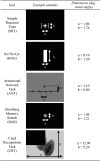Consumption of Iron-Biofortified Beans Positively Affects Cognitive Performance in 18- to 27-Year-Old Rwandan Female College Students in an 18-Week Randomized Controlled Efficacy Trial
- PMID: 28954841
- PMCID: PMC5657139
- DOI: 10.3945/jn.117.255356
Consumption of Iron-Biofortified Beans Positively Affects Cognitive Performance in 18- to 27-Year-Old Rwandan Female College Students in an 18-Week Randomized Controlled Efficacy Trial
Abstract
Background: Evidence shows that iron deficiency in adulthood may affect cognitive performance, possibly by disrupting neurotransmitter regulation or brain energy metabolism. Women of reproductive age (WRA) are among those who are most vulnerable to iron deficiency; however, they have been largely ignored in the literature relating iron status to cognition.Objective: Our aim was to determine the efficacy of iron-biofortified beans in improving cognition in WRA compared with control beans.Methods: A double-blind, randomized intervention study was conducted in 150 women aged 18-27 y with low iron status (ferritin <20 μg/L). Women were randomly assigned to consume iron-biofortified beans (86.1 ppm iron) or control beans (50.1 ppm iron) daily for 18 wk. Iron status was assessed based on hemoglobin, ferritin, transferrin receptor, and body iron values and on cognitive performance on 5 computerized tasks at baseline and endline.Results: Groups did not differ on any variables at baseline. Per protocol analyses revealed that consumption of the biofortified beans resulted in a 17% larger improvement in the speed of spatial selective attention; a nearly 7-fold larger improvement in the speed, a 68% greater improvement in the efficiency, and a >2-fold greater improvement in the specificity of memory retrieval; and a >2-fold larger improvement in the speed and a >3-fold larger improvement in the efficiency of memory search-all of which are relative to consumption of the control beans (P < 0.01 for all comparisons).Conclusions: Cognitive performance is sensitive to iron status, and consumption of iron-biofortified beans for 18 wk improved cognitive performance, especially the efficiency of search and the speed of retrieval on memory tasks, in young adult women. This trial was registered at clinicaltrials.gov as NCT01594359.
Keywords: Rwanda; biofortification; cognition; iron; women of reproductive age.
Conflict of interest statement
Author disclosures: LEM-K, MJW, SPS, SER, MGL, and JDH, no conflicts of interest. MJW and JDH served as paid technical consultants for HarvestPlus/International Food Policy Research Institute. The funders of this study had no role in the study design and implementation; data collection, analysis, and interpretation; or writing of the manuscript.
Figures



Similar articles
-
Consuming Iron Biofortified Beans Increases Iron Status in Rwandan Women after 128 Days in a Randomized Controlled Feeding Trial.J Nutr. 2016 Aug;146(8):1586-92. doi: 10.3945/jn.115.224741. Epub 2016 Jun 29. J Nutr. 2016. PMID: 27358417 Clinical Trial.
-
Changes in Iron Status Are Related to Changes in Brain Activity and Behavior in Rwandan Female University Students: Results from a Randomized Controlled Efficacy Trial Involving Iron-Biofortified Beans.J Nutr. 2019 Apr 1;149(4):687-697. doi: 10.1093/jn/nxy265. J Nutr. 2019. PMID: 30926992 Free PMC article. Clinical Trial.
-
Increased Iron Status during a Feeding Trial of Iron-Biofortified Beans Increases Physical Work Efficiency in Rwandan Women.J Nutr. 2020 May 1;150(5):1093-1099. doi: 10.1093/jn/nxaa016. J Nutr. 2020. PMID: 32006009 Free PMC article.
-
Iron biofortification interventions to improve iron status and functional outcomes.Proc Nutr Soc. 2019 May;78(2):197-207. doi: 10.1017/S0029665118002847. Epub 2019 Jan 30. Proc Nutr Soc. 2019. PMID: 30698117
-
Iron-biofortified staple food crops for improving iron status: a review of the current evidence.Curr Opin Biotechnol. 2017 Apr;44:138-145. doi: 10.1016/j.copbio.2017.01.003. Epub 2017 Jan 25. Curr Opin Biotechnol. 2017. PMID: 28131049 Free PMC article. Review.
Cited by
-
Modeling relationships between iron status, behavior, and brain electrophysiology: evidence from a randomized study involving a biofortified grain in Indian adolescents.BMC Public Health. 2022 Jul 6;22(1):1299. doi: 10.1186/s12889-022-13612-z. BMC Public Health. 2022. PMID: 35794587 Free PMC article. Clinical Trial.
-
The reduction in anemia through normative innovations (RANI) project: study protocol for a cluster randomized controlled trial in Odisha, India.BMC Public Health. 2020 Feb 7;20(1):203. doi: 10.1186/s12889-020-8271-2. BMC Public Health. 2020. PMID: 32033546 Free PMC article. Clinical Trial.
-
Biofortification: Future Challenges for a Newly Emerging Technology to Improve Nutrition Security Sustainably.Curr Dev Nutr. 2024 Oct 19;8(12):104478. doi: 10.1016/j.cdnut.2024.104478. eCollection 2024 Dec. Curr Dev Nutr. 2024. PMID: 39668944 Free PMC article.
-
In pursuit of a better world: crop improvement and the CGIAR.J Exp Bot. 2021 Jul 10;72(14):5158-5179. doi: 10.1093/jxb/erab226. J Exp Bot. 2021. PMID: 34021317 Free PMC article. Review.
-
Scaling-up biofortified beans high in iron and zinc through the school-feeding program: A sensory acceptance study with schoolchildren from two departments in southwest Colombia.Food Sci Nutr. 2018 Apr 25;6(4):1138-1145. doi: 10.1002/fsn3.632. eCollection 2018 Jun. Food Sci Nutr. 2018. PMID: 29983978 Free PMC article.
References
-
- Stoltzfus R. Defining iron-deficiency anemia in public health terms: a time for reflection. J Nutr 2001;131:565S–7S. - PubMed
-
- Stevens GA, Finucane MM, De-Regil LM, Paciorek CJ, Flaxman SR, Branca F, Peña-Rosas JP, Bhutta ZA, Ezzati M; Nutrition Impact Model Study Group (Anaemia). Global, regional, and national trends in haemoglobin concentration and prevalence of total and severe anaemia in children and pregnant and non-pregnant women for 1995–2011: a systematic analysis of population-representative data. Lancet Glob Health 2013;1:e16–25. - PMC - PubMed
-
- Rwanda - Demographic and Health Survey 2014 - 2015 [Internet]. Washington (DC): The World Bank; 2016 Jun 3 [updated 2017 Jun 7; cited 2016 Jun 8]. Available from: http://microdata.worldbank.org/index.php/catalog/2597.
Publication types
MeSH terms
Substances
Associated data
LinkOut - more resources
Full Text Sources
Other Literature Sources
Medical

